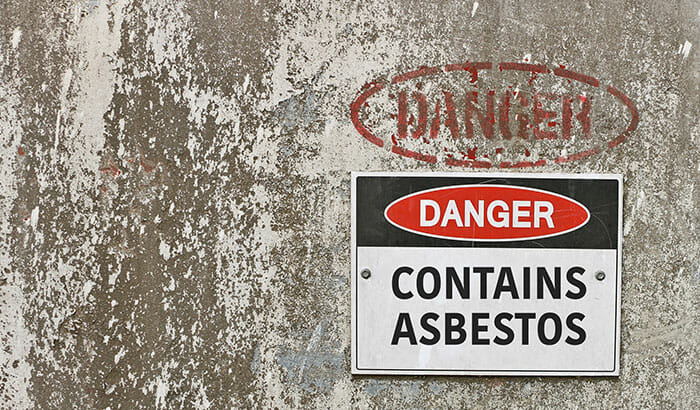For many years, we’ve heard about the dangers of asbestos, but what exactly is it, and what are the risks of exposure to it?
With all the controversy and ongoing dangers surrounding asbestos, it should be something everyone is aware of, but many of us are surprisingly uneducated about asbestos.
Every year, thousands of Americans die from Mesothelioma, cancer that asbestos causes. Luckily, information about asbestos is readily available, and the more you know, the safer you, your family, and your employees will be.
Here are answers to your biggest questions about asbestos.
What is Asbestos?
Asbestos is a natural substance found in six mineral formations: chrysotile, crocidolite, amosite, anthophyllite, tremolite, and actinolite. These minerals occur in different parts of the world, including the United States. Some of the largest concentrations of asbestos minerals are in California.
Asbestos is made up of bundles of microscopic fibers. These fibers are strong and heat resistant, which makes them ideal as insulation and fire retardant. Asbestos has been widely used in building materials, auto parts, and fireproof materials such as fabrics, packaging, and coatings.
Is Asbestos Harmful to People?
Yes. Because its fibers are so tiny, they can become airborne when disturbed. Breathing in these fibers can cause serious health effects on the lungs.
These effects include lung cancer, mesothelioma (a form of cancer that occurs in the chest and abdomen lining), and asbestosis, a progressive non-cancer disease that affects the lungs.
Symptoms resulting from asbestos exposure may take years to manifest, but they are life-threatening.
How Does Asbestos Exposure Happen?
Normally, asbestos fibers are not a threat if left undisturbed. Many buildings have had asbestos-containing materials (ACMs) for decades.
But when these fibers are disturbed, they can become airborne and easily inhaled. For example, a material is damaged by a fallen tree during removal or demolition. The dust can stay airborne for up to 72 hours before it settles, and because it is so light, it can quickly become airborne again.
Natural deposits of asbestos minerals do not threaten humans unless they are agitated by processes like mining.
Most known inhalation of asbestos occurs as a consequence of occupational exposure. Construction and demolition workers and asbestos miners are among the most frequent victims.
Is Asbestos Banned in the United States?
While asbestos used to be banned in the United States, it isn’t anymore. Most products containing asbestos were banned in 1989, but the ban was overturned for all but a few products just two years later. While most U.S. companies have stopped using asbestos, it isn’t illegal. And there are millions of older buildings that still contain asbestos.
The ban remains for corrugated paper, commercial paper, specialty paper, roll board, and flooring felt.
What Laws Are There Concerning Asbestos?
There are several laws and regulations on the books in the United States that govern asbestos use. Here are a few of them.
Asbestos Hazard Emergency Response Act – This act requires school administrators to inspect school buildings for asbestos. They must then create and submit a plan to minimize the danger of asbestos. Additional laws have updated this and provided funding to help schools comply with these requirements.
Asbestos Information Act – Requires manufacturers to provide information about the ACMs they produce and include widely known identifiers for these materials.
Federal Hazardous Substances Act – This specifically bans asbestos use in general-use clothing and “artificial ashes and embers.”
Significant New Use Rule – This EPA regulation requires manufacturers to notify the EPA 90 days before producing anything noted as a “new use.”
2002 mining ban – This meant asbestos could no longer be mined in the United States, but it didn’t ban importing asbestos from other countries.
How Do I Know if There’s Asbestos in My Home?
You can’t tell if a material contains asbestos just by looking at it, but it could be in ceiling material, floor tiles, piping, insulation, shingles, spackling compounds, etc.
When buying or renting a home, you could ask the owner if there are ACMs present, but there’s a good chance they won’t know, especially if the house was built before 1989 and they weren’t the original owner. Most home inspectors are not trained to look for asbestos, either.
To find out if any particular material contains asbestos, you need to contact a professional asbestos removal specialist to test it.
Again, if undisturbed, asbestos-containing materials don’t pose a threat. But if you are planning to demolish or renovate your home, or if your home sustains structural damage, you will need a professional to inspect the materials in question for asbestos.
How Can I Protect My Family and Employees from Asbestos?
As long as asbestos is undisturbed, it should not harm people. Whenever you build or renovate your home, make it clear to your contractor that you don’t want them to use ACMs in your construction.
Also, ensure that the affected area of your building is professionally tested for asbestos and have it removed by trained professionals.
Are There Alternatives to Asbestos?
There are alternatives to asbestos that provide insulation and heat resistance, including:
- Amorphous Silica Fabrics
- Cellulose Fiber
- Polyurethane Foams
- Flour Fillers
- Thermoset Plastic Flour
Let Bull Matrix Handle Your Asbestos Problem
Asbestos is a dangerous substance that should be left alone if you don’t have the proper training to remediate it.
Our state-accredited approach to removing asbestos starts with a plan to isolate the affected part of the home or office. We ask all occupants to leave until the job is complete.
We will remove all ACM within a vacuum-sealed structure and dispose of it in sealed waste bags later to be decontaminated. Our specialists will wear full-body protective clothing and shower in a decontamination chamber before exiting.
Do you live in northern or central Utah or southwest Wyoming? Are you planning to renovate your home or have areas of damage you suspect may contain asbestos? We’ll come and test your property and prepare for safe removal. Contact us today.

